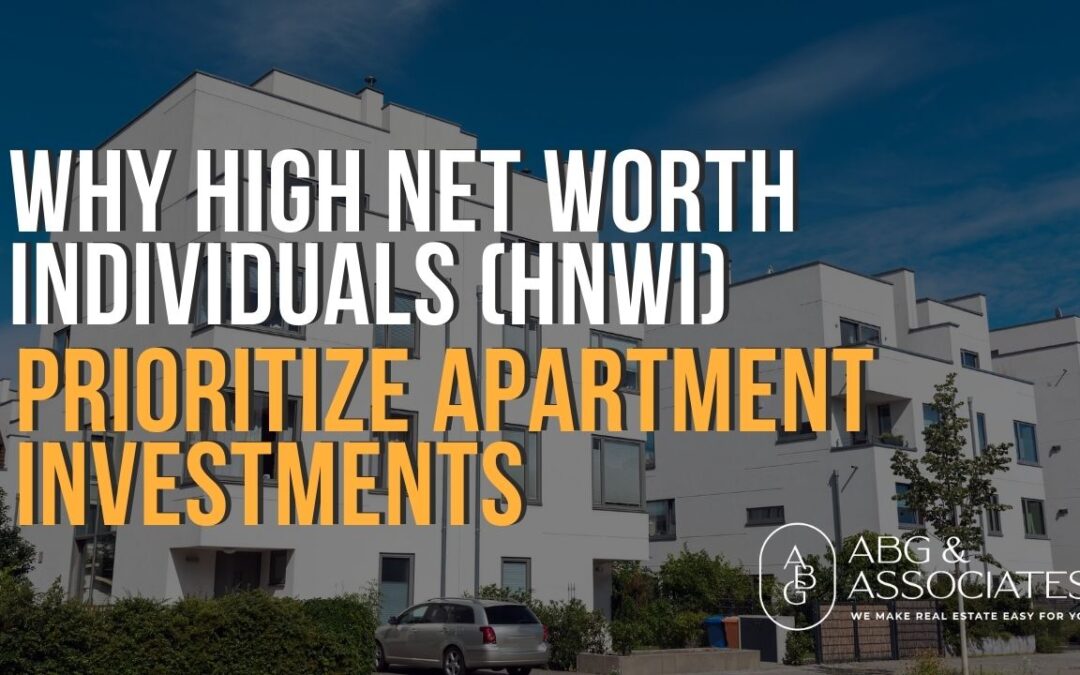When it comes to wealth management, High Net Worth Individuals (HNWIs) – typically those with significant investable assets, often exceeding US$1 million – are constantly seeking strategies that offer stability, growth, and tax efficiency. While their portfolios are diverse, one asset class consistently stands out as a preferred choice: multifamily real estate, particularly apartment buildings.
Why do these sophisticated investors choose apartments over other investment avenues? The reasons are rooted in fundamental economic principles, robust risk mitigation, and unique benefits tailored to large-scale wealth.
1. Stable & Predictable Cash Flow
Unlike volatile stocks or single-tenant commercial properties, apartments provide a diversified and remarkably stable income stream through rents.
- Built-in Diversification: With dozens or hundreds of units under one roof, a single vacancy has a minimal impact on the overall property’s income. This significantly reduces vacancy risk compared to single-family homes or even smaller commercial spaces.
- Essential Need: People always need a place to live. Even during economic downturns, demand for housing, especially affordable rental options, remains strong. This fundamental need makes rental income from multifamily properties highly resilient and predictable.
Research Finding: “Multifamily investments have shown adaptability across different economic downturns… For instance, during the early 1990s recession, multifamily was the only major property type to experience positive rent growth.” (EquityMultiple)
2. Powerful Tax Advantages
HNWIs understand that it’s not just about how much you make, but how much you keep. Multifamily real estate offers compelling tax benefits that significantly enhance after-tax returns:
- Depreciation: Investors can deduct a portion of the property’s value annually for tax purposes, even as the property appreciates. The recent permanent reinstatement of 100% bonus depreciation allows for significant upfront deductions, which can create passive losses to offset other passive income, and in some cases, active income.
- 1031 Exchanges: This allows for the deferral of capital gains taxes when selling one investment property and reinvesting the proceeds into another qualifying property, enabling wealth to compound tax-deferred.
3. Inflation Hedge & Recession Resilience
In an unpredictable economic landscape, multifamily real estate acts as a strong hedge against inflation and exhibits remarkable resilience during recessions.
- Inflation Hedge: As inflation rises, so do property values and, crucially, rental rates. This allows multifamily investments to maintain and even increase in value, protecting purchasing power.
- Recession Resilience: During economic downturns, the demand for rental housing often increases as people may postpone home purchases or face foreclosures. This consistent demand makes multifamily one of the safest asset classes across various market cycles.
Research Finding: “Compared to commercial real estate, multifamily properties offer lower volatility because the demand for rental housing remains relatively constant, even during economic downturns.” (BlueLake Capital)
4. Scalability & Access to Institutional-Grade Deals
Investing in apartments offers a highly efficient path to scale a real estate portfolio.
- Economies of Scale: Managing multiple units in one location is far more cost-efficient per unit than managing scattered single-family homes. Expenses like property management, maintenance, and insurance can be spread across many units, leading to higher net operating income.
- Access to Larger Assets: Through syndications and private funds, HNWIs can pool capital to invest in large, institutional-grade multifamily complexes (e.g., hundreds of units) that would be out of reach for individual investors. This provides access to professional management and sophisticated investment strategies.
5. Professional, Hands-Off Management
For HNWIs whose time is a valuable commodity, passive multifamily investing through syndications is ideal.
- Truly Passive: Experienced sponsors (General Partners) handle all aspects of the investment, from identifying and acquiring properties to managing day-to-day operations, renovations, and eventual disposition. This allows HNWIs to benefit from real estate without the typical landlord responsibilities.
- Expertise Leverage: Investors gain access to the specialized knowledge, networks, and operational efficiencies of seasoned real estate professionals.
6. Portfolio Diversification
Multifamily real estate offers a distinct asset class that often behaves differently from stocks, bonds, and other traditional investments.
- Reduced Correlation: Real estate returns often have a low correlation with public market fluctuations, providing a valuable buffer and reducing overall portfolio risk.
- Tangible Asset: Unlike paper assets, real estate is a tangible, foundational asset that provides a sense of security and long-term value.
Research Finding: Wealth management reports, such as those from PwC and Capgemini, consistently show that HNWIs are increasingly allocating portions of their portfolios to alternative investments, with private real estate (including multifamily) being a significant component due to its diversification benefits and attractive risk-return profile. (PwC, Capgemini, Blackstone)
Conclusion
The consistent preference of HNWIs for apartment investing isn’t by chance. It’s a strategic alignment of their financial goals with an asset class that inherently offers stable cash flow, powerful tax advantages, robust inflation protection, scalability, professional management, and crucial portfolio diversification. For those looking to grow and preserve significant wealth with a hands-off approach, multifamily real estate remains a cornerstone investment.

